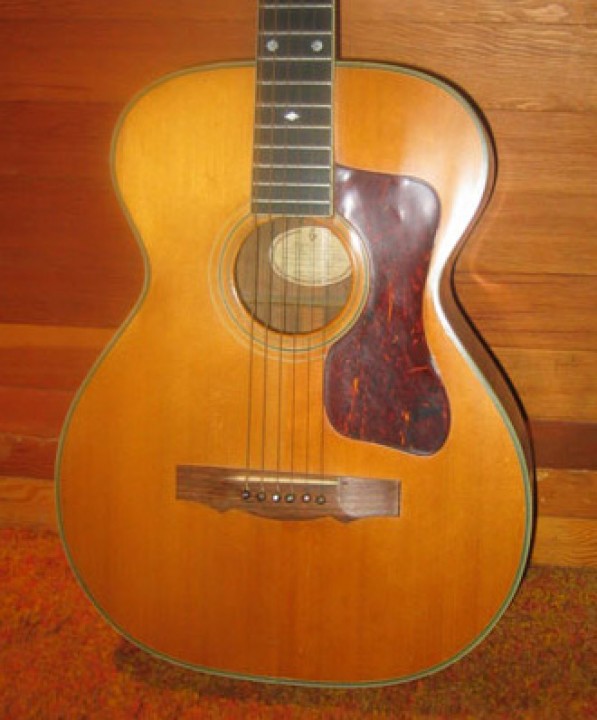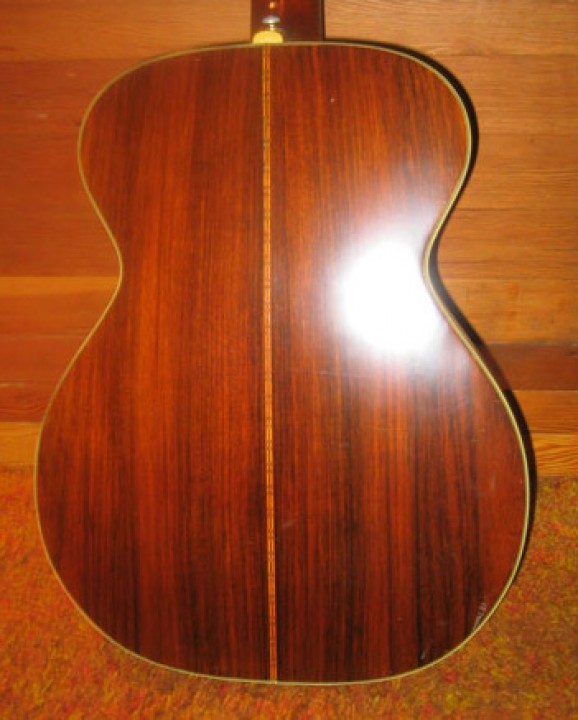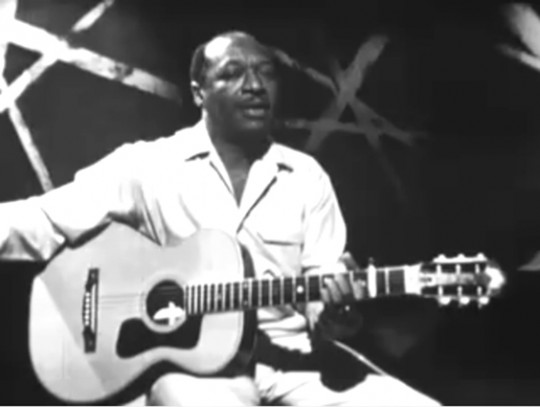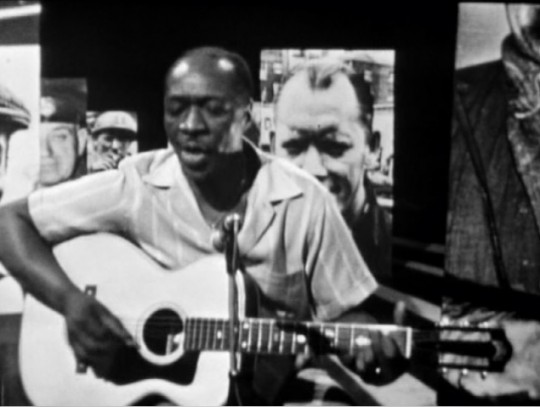Josh White's Guild Guitar

For me the story of Josh White’s Guild started during the early ‘90s when I was still doing the research for 'The Guild Guitar Book'. At that time I was interviewing Carlo Greco and Gilbert Diaz on a regular basis, to try and gather as much information as possible about the early days of Guild. Some of our talks were about instruments that were made for specific people or artists and so we discussed the guitars Guild had made for George Barnes, Merle Travis, Duane Eddy, Paul Simon, John Denver, Tiny Grimes and many more. Some of these guitars had made it to actual ‘signature’ models like the George Barnes and the Duane Eddy but most of them were one-off instruments that were just done at the request of the artist. Now Guild never kept records of these ‘Special’ guitars and for these people that worked at Guild it was hard to remember all the specifics of these one-off guitars of which some had been made more than 25 years earlier. Showing them pictures of the actual guitars would usually trigger their memories and very often they would be able to give me more specific details about materials, construction etc.
One of the more obscure instruments we discussed was a guitar that was made for Josh White. Carlo Greco vividly remembered Josh White’s visit to the Hoboken plant and the instrument that was made for him. According to Carlo it was based on the model F-30, but with a rosewood body and a wider, classical style neck. Since Josh had been playing a Martin 00-size guitar with a 12 fret neck and a 1-7/8” wide fingerboard for a long time, the Guild had to have the wide fingerboard as well. The neck that was used was made of an actual Guild Mark classical neck blank; 2 pieces of mahogany with a maple center strip and the typical ‘classical’ style heel, which was really different from the heel you would usually find on a Guild steel string guitar. It also featured a slotted headstock and a 25-1/2’ scale, features that were not standard on the regular model F-30 from that particular period. Another feature of the guitar were the ‘DeLuxe’ inlays that Guild had started using on some “Special Order’ guitars. The inlays were put into the ebony fingerboard and on the wings of the bridge. Unlike the regular F-30, which had tortoise style binding, the guitar that was made for Josh did get white binding around the top and back and the fingerboard was bound as well.
I wrote down all the info Carlo gave me and at some point during my research I came across some old, rather poor-quality footage of Josh White that showed him playing what looked like the Guild guitar that Carlo had described but I never saw any good quality pictures of Josh White with the Guild. Since I only had Carlo’s description, the info never made it to the book.
Fast forward to November 2007, when I received an e-mail from the producers of ‘History Detectives’:
This is S. Y. writing from the PBS show History Detectives (http://www.pbs.org/opb/historydetectives/ ).
We explore U.S. history through the use of viewer-contributed objects.
This season, one of our contributors sent in questions about a guitar he says belonged to Josh White. The circa 1959 guitar was supposed to have been the first signature guitar produced for an African-American, and was supposed to have been designed and built by the Guild Guitar Company. For some reason, the guitars were never manufactured.
Walter Carter at Gruhn Guitars suggested I write you. I’m trying to locate any former Guild employees who might be able to verify that a signature guitar was planned for White and why it wasn’t made.
I’ve attached some of the guitar photos for your review/opinion/curiosity. I’m trying to verify the above facts.
Any help you can offer is greatly appreciated.
Thanks in advance for your time,
S.
S. Y.
Associate Producer, History Detectives
304 Hudson St., 5th Floor
NY, NY 10013
These are the photos that came with the e-mail from the ‘History Detectives’:


The photos didn’t show a lot of detail nor did any of them show the entire guitar but they did confirm what Carlo had told me almost 15 years earlier about a guitar made more than 25 years before that. The only thing that I didn’t see in the photos were the inlays in the bridge, but since the guitar had been made such a long time ago, I assumed that Carlo could have been mistaken about those.
I was quite excited about the fact that the producers had contacted me because here was a chance to learn a little more than what Carlo had told me and I wrote the following e-mail to the producer of History Detectives, hoping to get some more information about the guitar in question:
Hello S. ,
Thanks for your e-mail. I looked at the photos and with what I know about Guild guitars I came to the following conclusion:
This guitar was definitely not made during the late '50s. Because of certain design features I would date it to approx. 1966. It will probably have the 'Special' designation as part of the model written on the label.
If I would have to guess (and following the logic behind regular Guild model designations) it will probably say 'F-30NT-Special’ on the label.
I already talked to a person who was a foreman at that time and he remembered a guitar being made for Josh White but he did not remember any negotiations re. a Josh White Model.
Around 1966 Josh White was working together with the people who wanted to start up a new guitar company.
This company would become Ovation (in Connecticut) and one of the early models they came out with was a model that was based on Josh White’s ideas. This model was called the 'Josh White Model' and was introduced in 1967. The model stayed in the line up till Josh White died in 1969. After that the model name was changed.
Maybe people have been mixing up the two different stories. There may have been talks about a possible Guild Josh White model, but nothing had been seriously discussed yet. Either way, Josh got together with Ovation very soon after that particular Guild guitar was built (that is, if it was built when I think it was built) so that must have been the end of any talks with Guild (if there ever were any!).
Now you didn’t include any complete photos of the instrument and I would love to see some better photos of the complete guitar. The foreman described some of the features of the guitar and I would like to verify that information with photos of the instrument. Also do you think you could get me the complete model designation that’s written on the label and the complete serial number. With that information I should be able to date the guitar exactly. If you can’t give me that information, could you get me in contact with the current owner of that particular Guild guitar.
I hope this info is of some help to you. If you or the current owner of the guitar have any additional questions, feel free to contact me again and I will try to help you out.
Looking forward to hearing back from you.
Sincerely, Hans Moust
Shortly after my e-mail I received the following message back:
Hi Hans,
I got your message and appreciate your prompt and thorough reply. I’m waiting for our contributor to send me the information you asked, i.e., the serial number and a full photo of the guitar. I can eventually put you in touch with the contributor after we’ve wrapped production on the show.
I’ll send you the new information as soon as I get it.
Thanks again, S.
Meanwhile I had decided to investigate the matter a little further myself. I found some more footage of Josh White on the internet and these film clips did not only show the guitar rather well, but to my surprise they also showed the inlays in the bridge that Carlo had been talking about. And after looking a little more closely I discovered that the guitar in the clips not only had the inlays on the bridge, but it also had a different size pickguard than the guitar in the photos I had gotten. After finding several other small discrepancies it opened up the possibility that the guitar that Josh was playing in the clips, might not be the same guitar as the one pictured in the photos that were sent to me by the makers of ‘History Detectives’.
Here's a still from one of the clips I found on the internet:

As you can see the bridge has small inlays on the wings. The pickguard in the 'still' photo is quite a bit smaller than the pickguard in the color photo. Notice how much closer the pickguard is to the bridge in the color photo and also how much closer the pickguard is to the edge of the body near the waist, but obviously one could argue that both the bridge and the pickguard could have been changed.

So I got in contact with Carlo Greco again and asked him if he had made more than one of these guitars at the time. Carlo responded that he didn't remember but he agreed with me that the ‘stills’ I had sent him of the Josh White guitar in the clips showed a different looking guitar from the one in the photos sent to me by the producer of the program.
After 6 months I was still waiting for the History Detectives to get back with me so I decided to write the program makers the following note:
Hello S.,
Still no news from the owner of the 'Josh White' Guild guitar?
Sincerely,
Hans Moust
On May 13, 2008 I get the following e-mail from the History Detectives:
Sorry. We’ve completed the episode.
What kind of information are you looking for exactly? I forgot.
Here’s what happened though…we were able to positively ID the guitar as Josh White’s. His son agreed to be on the show and told us he had, indeed, sold the guitar to a guitar shop because he wasn’t interested in keeping it.
And we were able to solve the question of why Josh did not sign with Guild.
Let me know if you have more specific questions and I’ll try to answer them for you.
Cheers,
S.
At that point I couldn’t do much more than wait for the show to be aired on US Television and hopefully the makers of the program would get me in contact with the owner of the guitar after that, like they had promised.
I did get a notification from the producers during January 2009 that the show would be aired the following month and since I expected they would have talked to many other people, I waited in anticipation for what they had discovered after they had gotten my initial letter.
Since I’m located in the Netherlands I didn’t get to see the show at the same time as the US viewers but I did see it shortly after that on the internet.
If you haven't seen it yet, here's the link:
JoshWhiteGuitar
First of all I would like to state that I truly enjoyed the fact that a Guild guitar was the subject of a TV show and also the fact that it was about Josh White who had been an important figure in the folk/blues movement of the ‘50s and ‘60s. At the same time I was really disappointed with the amount of research that the people who cooperated or appeared in the show had done themselves other than looking at the guitar and concluding that it was the one that Guild had made for Josh White.
Mark Dronge’s explanation of how the Guild Josh White Model never came to be sounded somewhat ‘thin’ but it’s an acceptable story, especially in the light of Guild’s usual failure to attract the right players that could help change the ‘image’ of Guild guitars in general.
However I didn't agree with the makers of the program that the guitar in question was positively ID’d as the guitar that was owned by Josh White.
After looking at the photos of the guitar in question and looking at the available footage of Josh White playing the Guild guitar I could only conclude that there may have been another one of these guitars made and that the guitar investigated by the History Detectives might not be the guitar that was once owned by Josh White.
Hans Moust

Edit
Originally this story ended with my conclusion that I was not convinced that the guitar investigated by the History Detectives once belonged to Josh White. The makers of the program had gotten me in contact with the owner of the guitar, who promised to answer all the questions I had, but somehow that never happened. So it looked like that was 'end of story' for me.
But that's not where the story ends!
To be continued!


 The photos didn’t show a lot of detail nor did any of them show the entire guitar but they did confirm what Carlo had told me almost 15 years earlier about a guitar made more than 25 years before that. The only thing that I didn’t see in the photos were the inlays in the bridge, but since the guitar had been made such a long time ago, I assumed that Carlo could have been mistaken about those.
I was quite excited about the fact that the producers had contacted me because here was a chance to learn a little more than what Carlo had told me and I wrote the following e-mail to the producer of History Detectives, hoping to get some more information about the guitar in question:
The photos didn’t show a lot of detail nor did any of them show the entire guitar but they did confirm what Carlo had told me almost 15 years earlier about a guitar made more than 25 years before that. The only thing that I didn’t see in the photos were the inlays in the bridge, but since the guitar had been made such a long time ago, I assumed that Carlo could have been mistaken about those.
I was quite excited about the fact that the producers had contacted me because here was a chance to learn a little more than what Carlo had told me and I wrote the following e-mail to the producer of History Detectives, hoping to get some more information about the guitar in question:

 So I got in contact with Carlo Greco again and asked him if he had made more than one of these guitars at the time. Carlo responded that he didn't remember but he agreed with me that the ‘stills’ I had sent him of the Josh White guitar in the clips showed a different looking guitar from the one in the photos sent to me by the producer of the program.
After 6 months I was still waiting for the History Detectives to get back with me so I decided to write the program makers the following note:
So I got in contact with Carlo Greco again and asked him if he had made more than one of these guitars at the time. Carlo responded that he didn't remember but he agreed with me that the ‘stills’ I had sent him of the Josh White guitar in the clips showed a different looking guitar from the one in the photos sent to me by the producer of the program.
After 6 months I was still waiting for the History Detectives to get back with me so I decided to write the program makers the following note:
